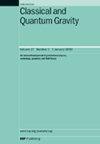线性三镜腔的谐振特性和稳定性
IF 3.6
3区 物理与天体物理
Q2 ASTRONOMY & ASTROPHYSICS
引用次数: 0
摘要
引力波探测器中Fabry-Perot空腔的实现对于提高引力波探测器的灵敏度至关重要,使其能够以更高的信噪比观测到越来越多的宇宙事件。值得注意的是,法布里-珀罗空腔在频率依赖压缩技术中起着关键作用,该技术在整个观测频谱上提供了量子噪声的减少。在本文中,我们首先介绍了线性三镜腔共振特性的适应性,以及我们可以对其进行的实时控制,对于未来探测器的频率依赖压缩,特别是爱因斯坦望远镜项目,将是有趣的。在这种观点下,我们开发了一个完整的模型来描述一个线性三镜腔的稳定性行为和透射和反射场的性质,旨在用于设计目的。特别地,通过仿真显示了它们可以显示的特征双共振峰(该系统的关键特征之一)作为腔参数的函数的演变。我们表明,双峰形状几乎可以自由调节,无论是在最大值之间的间距,它们的相对振幅和固有宽度。这可以通过改变反射镜的反射率系数和子腔的微观/宏观长度来实现。然而,可实现的实际配置的数量受到腔的稳定条件的限制。特别是,如果两个子腔的宏观长度不相同,则很难获得稳定的三镜腔。为了得到一个稳定的系统,研究了不同的几何形状。本文章由计算机程序翻译,如有差异,请以英文原文为准。
Resonant behavior and stability of a linear three-mirror cavity
The implementation of Fabry–Perot cavities in gravitational-wave detectors has been pivotal to improving their sensitivity, allowing the observation of an increasing number of cosmological events with higher signal-to-noise ratio. Notably, Fabry–Perot cavities play a key role in the frequency-dependent squeezing technique, which provides a reduction of quantum noise over the whole observation frequency spectrum. In this paper, we first present how the adaptability of resonance properties of linear three-mirror cavities, and the real-time control we could have on it, would be interesting for frequency-dependant squeezing in future detectors, especially for Einstein Telescope project. In this view, we develop a complete model to describe the stability behavior and the properties of transmitted and reflected fields of a linear three-mirror cavity aiming to be used for design purposes. In particular, simulations are carried out to show the evolution of the characteristic double resonance peak they can show-off, which is one of the key features of this system, as a function of cavity parameters. We show that the double-peak shape is almost freely adjustable, either in terms of spacing between maxima, their relative amplitude and intrinsic width. This is made possible by changing the mirrors’ reflectivity coefficients and the sub-cavities microscopic/macroscopic lengths. However, the amount of achievable realistic configurations is limited by the stability conditions of the cavity. In particular, if the two sub-cavities do not have the same macroscopic length, it could be difficult to obtain a stable three-mirror cavity. Different geometries have been studied to obtain a stable system.
求助全文
通过发布文献求助,成功后即可免费获取论文全文。
去求助
来源期刊

Classical and Quantum Gravity
物理-天文与天体物理
CiteScore
7.00
自引率
8.60%
发文量
301
审稿时长
2-4 weeks
期刊介绍:
Classical and Quantum Gravity is an established journal for physicists, mathematicians and cosmologists in the fields of gravitation and the theory of spacetime. The journal is now the acknowledged world leader in classical relativity and all areas of quantum gravity.
 求助内容:
求助内容: 应助结果提醒方式:
应助结果提醒方式:


